Causes of a boil
introduction
A boil is inflammation of a hair follicle and surrounding tissue. A boil can appear anywhere on hairy skin and usually occurs spontaneously without a direct trigger. Most often the inflammation comes from the bacteria Staphylococcus aureus that migrates along the hair through a skin injury down to the hair follicle. In the course of the process, the affected tissue dies and a purulent fusion forms, which stands out as a pus focus in the center of the reddened and swollen skin section. Often times, boils are associated with a weakened immune system.
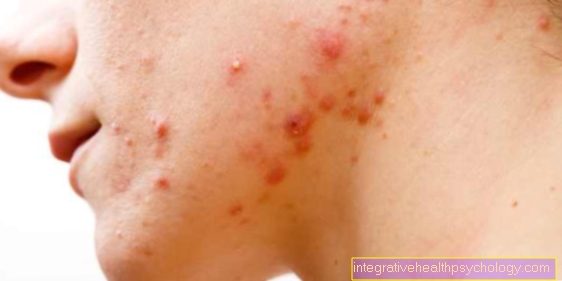
Causes of the development of a boil
Cause diabetes mellitus
Diabetes mellitus can promote the development of boils. If the diabetes mellitus is well treated or adjusted, this means that boils also occur less frequently. In some cases, it is only the newly emerging boils that lead to the diagnosis of untreated diabetes mellitus.
The reason for this interplay between diabetes and furunculosis is probably a wound healing disorder and immune deficiency, which is more common in diabetics. In the context of diabetes mellitus, the blood circulation in the skin deteriorates. As a result, wounds can heal more poorly, as the healing process is inevitably linked to good blood circulation.
It is known that people who suffer from diabetes mellitus are less able to fight off pathogens. The exact process that leads to diabetics with a derailed metabolic condition showing an immune deficiency has not yet been clarified. The immune system also affects skin infections. Therefore, if a metabolic disorder is not treated, such as diabetes mellitus, boils may develop more frequently.
Read more about this under Consequences of diabetes mellitus
Pimples
A pimple, also called a pustule in the medical field, represents a cavity in the superficial layer of skin. This is filled with pus. The pus is a biological product that arises from tissue melting and submerged white defense cells. The defense cells are located in the blood and form part of the immune system. They migrate into the tissue as part of an inflammatory reaction and secrete enzymes that lead to tissue melting. Some bacteria can also lead to the dissolution of the tissue and thus the formation of a pus cavity.
Often, pimples occur as part of acne. This leads to a blockage of skin pores, which means that sebum and other substances can no longer be excreted. Bacteria can multiply and inflammatory cells are attracted. This creates a pus-filled pimple.
Read more about this under Acne - This works best
Pimples are more common during puberty. This is based on one hormonally controlled increased sebum production and enlargement of sebum glands and an increased increase in horn cells. The role of hormones also explains the relationship between the number of pimples and the woman's menstrual cycle. It is also believed that high-fat foods and dairy products promote the development of pimples. Genetic factors also play a role.
Boils and pimples generally have a very similar appearance, as both are pus cavities. However, a boil is more careful to handle than the pimple. When opening the boil, strict hygiene is to be observed and in the early stages pressing around on the boil must be strictly avoided to prevent it from spreading. In contrast to pimples, boils always arise from an inflammation of the hair follicle and begin in deeper layers of the skin. The bacterial colonization may also be different.
Read more about this under Pus pimples - causes, occurrence and treatment
Testosterone as the cause
Testosterone has a wide range of effects on the skin and promotes the development of boils. On the one hand, testosterone leads to increased hairiness on the skin. Thus, the increased presence of hair follicles also increases the risk of inflammation of the hair follicles. In addition, a thick beard makes cleaning the skin more difficult and must therefore be kept clean.
In addition, testosterone increases the production of sebum, which makes it easier for the pores to clog and for boils and pimples to develop. The skin is generally oily from testosterone than without the effect of the hormone and has more pores. This can lead to a rougher skin texture.
It has also been found that testosterone has an influence on the skin's barrier function.For example, wound healing is slower under testosterone, which makes the penetration of bacteria more likely.
Mental causes
The psyche also plays an important role in the development of boils. It is believed that psychological stress leads to a less active immune system or reduced defenses. This, in turn, favors the occurrence of boils. It can be observed that boils occur more frequently in times of stressful stressful situations.
A permanent lack of sleep not only affects the mood, but also limits the immune system. In order to keep the psychological stress lower, good sleep hygiene and regular exercise should be observed. This strengthens the immune system and thus also reduces the number of boils.
Read more about this under Sleep hygiene
Cause chemotherapy
Chemotherapy usually involves so-called cytostatics. These intervene in the cell cycle and prevent cells from multiplying. This particularly affects cells that divide frequently and thus multiply. This applies primarily to tumor cells. However, most chemotherapeutic agents do not target the tumor cells, but also attack all other rapidly dividing cells. An example of this are the blood cells, which also include the white blood cells of the immune system. The chemotherapy leads to a reduction in the immune cells, which means that infections, such as boils, can develop more easily.
Causes of a boil on the face
In the face, increased sebum production plays an important role in the development of boils. People with excessive sebum secretion generally tend to have oily skin. Furthermore, the use of oily creams on dry skin can promote the closure of the pores and lead to inflammation of the hair follicle.
Increased sweating can also play a role. However, this is more relevant on parts of the body that are additionally stressed by tight clothing and therefore the sweat cannot evaporate in the fresh air.
In addition, inadequate hygiene when shaving a beard leads to the development of boils on the face (see also: Boils on the lip). Small wounds on the skin regularly occur during shaving, which prevent the entry of bacteria such as the skin bacterium Staphylococcus aureus. This in turn can lead to boils. This can be avoided by cleaning the razor regularly and disinfecting the skin of the face after shaving. This can e.g. with the help of an alcohol-containing after-shave.
Causes of a boil in the nose
The same risk factors generally apply to nasal furuncles as to boils in other parts of the body. Additionally, boils in the nose often appear after hair removal from the nose. By pulling out the hair, small wounds occur, which often cannot be disinfected or kept clean due to the difficult-to-reach location. As a result, bacteria can penetrate the skin, which lead to inflammation of the hair follicle. But unmanipulated long nose hairs are also a risk factor for boils.
Furthermore, the environment in the nose is very favorable for bacteria to multiply. The area is protected from fresh air and therefore always remains slightly humid and warm. In addition, it is relatively difficult to keep the nasal entrance completely still, as the skin region is constantly moved when speaking, eating and blowing the nose. This can make inflammation worse and contribute to its spread.
Chronic inflammation of the nasal mucous membrane can also promote the development of boils.
A nasal furuncle should always be opened by a dermatologist. Opening it on its own can lead to the spread of bacteria and severe infections, which can also spread to the meninges or lead to blood poisoning.
Treatment / care after an operation
A boil can be opened surgically. After this short operation, which usually does not require general anesthesia, the wound must be rinsed and cleaned with disinfectant over a longer period of time in order to avoid re-infection. In the first time after the operation, a doctor should be consulted regularly for control purposes.
The surgical site is left open so that pus can continue to leak. Nevertheless, a new accumulation of pus can sometimes occur in the course of the disease. In this case, a second operation may be necessary. To reduce the likelihood of the boil recurring, it is important that the entire pus cavity including the submerged tissue in the area is removed. Leftovers often lead to renewed inflammation.
To prevent the bacteria from spreading in the body after the cavity has been opened, an antibiotic can be taken after the operation. An increase in body temperature should be recognized early as it is the first indication of a systemic infection after the operation.

.jpg)






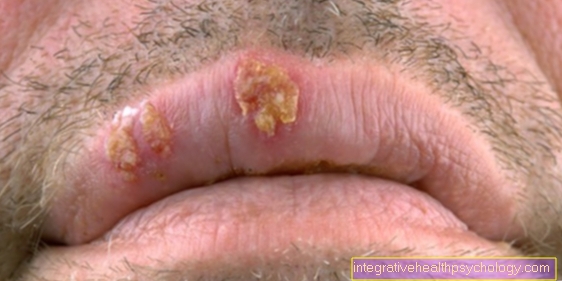







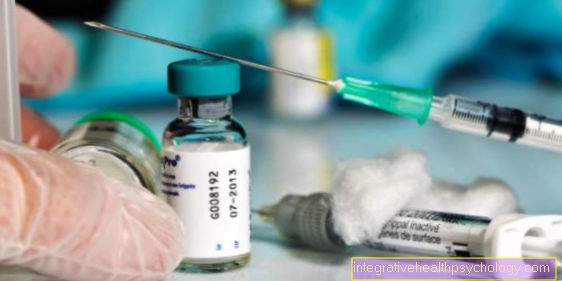
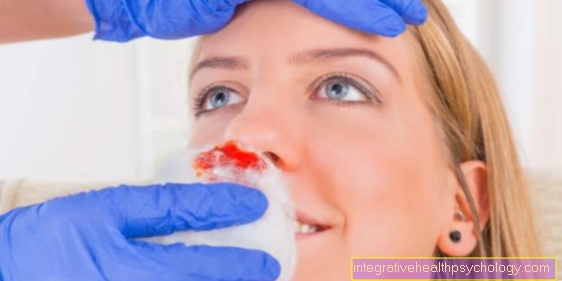
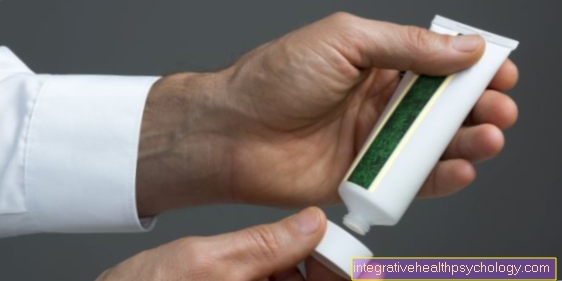



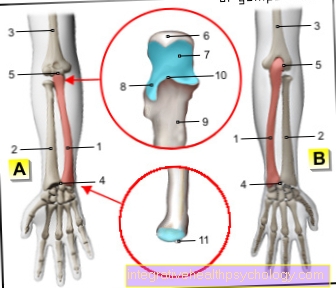
.jpg)





